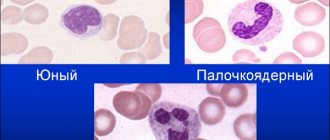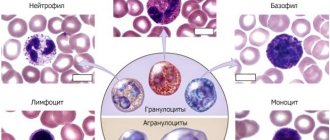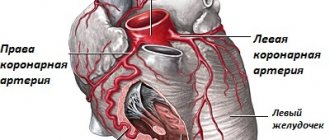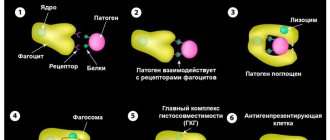Neutrophils are one of the components of the leukocyte formula, a decrease in the level of which characterizes inflammatory processes, blood diseases, and in some cases indicates the occurrence of other pathologies in the body. In medical practice, a reduced level of neutrophils is called neutropenia, but what is the reason for this phenomenon - let's figure it out.
What are neutrophils and how are they formed?
Neutrophils (neutrophil lymphocytes) are granulocytic blood cells (the name is due to the presence of granules in the cytoplasm), which are part of the leukocyte formula and are responsible for suppressing foci of infection.
The content of neutrophils in the blood ranges from 45 to 70% of the total number of leukocytes.
There are two forms of neutrophils in human blood: band-nuclear and segmented; the fundamental distinguishing feature of both forms lies in the “age” of the cells. Band neutrophils are young cells formed by red bone marrow; their nucleus is one solid rod.
Subsequently, the cell enters the blood plasma, where it matures to a segmented form, that is, the rod is divided into segments. Neutrophil lymphocytes remain in the peripheral blood for only 2-3 hours, and then migrate to tissue structures. Moreover, the lifespan of such cells directly depends on the presence of pathological processes in the body and ranges from 2-3 hours to 2-4 days.
Leukocytes are also called white blood cells or white blood. They are responsible for the human immune system, a barrier established by the body against diseases, toxins, various viruses and harmful bacteria. Read more in the article: “why leukocytes in the blood are elevated, causes and symptoms.”
Classification
The cells are produced in the bone marrow.
Depending on their maturity, neutrophils are divided into 6 groups:
- Myeloblasts. It is formed from stem cells in the bone marrow. This cell is the basic one. Subsequently, it is transformed and modified.
- Promyelocytes. The cell is of considerable size and round in shape. The key to the structure of promyelocytes is the nucleus, which fills almost the entire volume of the cell.
- Myelocytes. The element decreases in size and acquires the correct shape. The color of the kernel is bright purple.
- Metamyelocytes. They are small in size and round in shape. The core resembles the outline of a horseshoe.
- Band neutrophils. The main part of the cell is occupied by the cytoplasm - semi-liquid content. The core narrows.
- Segmented neutrophils. The cell differs from the rod cell in the structure of the nucleus, which is divided into segments. A segment is a part in the form of a lobule. Other characteristics: size, cytoplasmic volume, granular structure do not change. A segmented neutrophil is a mature cell. The remaining groups are immature elements and are much smaller in number.
Neutrophil function and indications for their determination
The leukocyte formula gives a general idea of human immunity and includes a harmonious ratio of five leukocytes: monocytes, eosinophils, lymphocytes, neutrophils and basophils. Violation of the norm of these indicators in a general blood test helps to recognize pathologies, including malignant neoplasms.
Indications for a general blood test, in particular to determine the quantitative ratio of the neutrophil fraction, are the following diseases:
- upper respiratory tract diseases (sore throat and pneumonia);
- pathologies of parenchymal organs (pancreatitis and cholecystitis);
- sepsis, gangrene and extensive burns of the skin;
- heart attack;
- tuberculosis;
- hypoplastic and aplastic anemia;
- blood loss;
- appendicitis and peritonitis;
- chemical poisoning;
- rheumatic attacks.
In general, leukocytes perform a protective function for the body: they create a barrier to pathogenic microflora (infections, viruses and bacteria), and are also designed to absorb pathogenic bacteria, the products of their vital activity and decay.
When a virus enters the human body or an inflammatory process begins, the body temperature rises, thus the immune system fights the pathogen. Read more in the article: “lowering body temperature at home.”
The leukocyte protective barrier involves the complex functioning of individual factions, each of which strictly performs its own functions. Thus, the task of neutrophils is to absorb pathogenic microorganisms and break them down in their own body. Having completed its “mission,” the neutrophil lymphocyte dies, forming exudate and attracting other leukocyte cells. At the same time, the neutrophil secretes antibacterial substances and enzymes.
The mechanism is simple: if there is a focus of inflammation in the body, a segmented (adult) neutrophil from the blood is directed to the pathogenic focus, so its quantitative ratio with other leukocytes in the blood stream may temporarily decrease. A sharp decrease in cell levels in some cases occurs due to intensive therapeutic methods such as radiation or chemical therapy.
How to maintain normal neutrophil levels
To have normal levels of segmented neutrophils, you should take care to support your immunity and not waste it. Particular importance should be given to a woman’s environment during pregnancy.
- Vitamins from fruits and vegetables have a positive effect; food should be moderately high in calories and varied.
- According to indications, you should get vaccinated against influenza and other diseases, without waiting for the beginning of the period of increased incidence.
- To the usual hygiene rules of washing hands with soap, you should add rinsing your nose with clean water. Cleansing the mucous membrane and villi improves their protective function.
Hardening procedures can relieve the body of many problems.
Blood test and its interpretation
Advertising:
A general blood test allows you to determine the percentage of the neutrophil fraction with other cells. Blood sampling is carried out in a standard way: from a vein or finger in the morning on an empty stomach.
Neutrophils react more to a bacterial infection, and lymphocytes - to a viral one.
Based on the functional characteristics of leukocytes and their ratio, the nature of the disease is judged:
- during an acute viral infection, segmented neutrophils are reduced, and leukocytes and lymphocytes are increased;
- with chronic ARVI, segmented cells and leukocytes are reduced, and lymphocytes are increased;
- with bacterial damage to the body, the ratio changes in the opposite direction: leukocytes and neutrophils increase, and lymphocytes, on the contrary, will decrease.
At the same time, the total level of monocytes, eosinophils and basophils during ARVI increases slightly and is rarely diagnosed, mainly during pregnancy. To identify such inflammatory processes, ESR - erythrocyte sedimentation rate - is taken into account.
Bacterial damage has a more complex biological form, in contrast to the viral nature of the disease. Therefore, by identifying the amount of the neutrophil fraction, dangerous diseases caused by: Escherichia coli, Koch and Leffler bacilli, clostridia, and treponema pallidum are reliably determined.
Results
Segmented neutrophils are mature neutrophils (a type of leukocyte) responsible for eliminating infections, primarily the activity of pathogenic bacteria. With bacterial infection, the number of segmented cells increases.
In clinical practice, this is an indicator of an acute infectious process. Sluggish chronic diseases of bacterial etiology and viral diseases are not accompanied by an increase in the values of segmented cells. Chronic neutrophilia may indicate the development of oncological processes.
Decoding the norms for neutrophil lymphocyte indicators
The state of the human immune system when deciphering the analysis is determined by the percentage of young and mature cells. The normal indicators do not depend on gender; for women and men the percentage of neutrophils will be the same. But at the same time, the patient’s age is taken into account.
Band cells are always elevated in infants and make up from 3 to 12% of the total number of leukocytes, but by the month of life the balance between young and mature cells returns to normal.
In children under 3 years of age, immunity has not yet been formed, so the percentage of segmented cells may fluctuate, which is also considered normal within acceptable values.
Advertising:
The following are the norms for neutrophil levels in a child, adolescent and adult.
| Person's age | Band cells | Segmented cells |
| Newborn | 3-12% | 46-70% |
| Infant up to 2 weeks of life | 1-5% | 30-50% |
| Infant from 2 weeks to a year of life | 1-5% | 16-46% |
| 1-2 years | 1-5% | 28-48% |
| 3-5 years | 1-4% | 32-55% |
| 6-7 years | 1-4% | 37-58% |
| 8-9 years | 1-4% | 41-60% |
| 10-11 years | 1-4% | 43-60% |
| 12-15 years | 1-4% | 45-60% |
| from 16 years old and adults | 1-3% | 45-70% |
Before conducting a general analysis, you need to warn your doctor or stop taking certain medications that distort the level of neutrophil granulocytes. These include: sulfa drugs, diuretics, corticosteroids, penicillin drugs and analgesics.
Causes of low blood cell levels
The etiology of a possible decrease in neutrophil granulocytes is divided into three types:
- Congenital;
- Acquired;
- Idiopathic (for unknown cause).
Advertising:
Congenital neutropenia is dangerous primarily for the child, since the unformed weakened immune system “misses” pathogenic microorganisms. For this reason, young children can often get sick with subsequent complications. As you grow older, the pathology softens due to the body's adaptation: missing leukocytes are replaced by other fractions of the leukocyte formula.
For people of any age, the phenomenon of neutropenia against the background of ongoing agranulocytosis is dangerous - the death of immature neutrophils, which requires long-term and complex therapy.
Also in medical practice, a reduced level of the neutrophil fraction, taking into account the severity of the pathology, is divided into mild, moderate and severe neutropenia. The degree of reduction in this case is due to ongoing pathological processes in the body due to which neutrophils are quickly destroyed or produced in insufficient quantities. Determining the primary source is the task of the hematologist.
The causes of acquired neutropenia differ in adults and children. Let's look at them.
Decreased granulocytes in children
If the reasons for the low level of segmented cells are not due to a lack of bone marrow function or other congenital anomalies, the primary source is sought among the following diseases:
- infections such as influenza, measles, rubella, hepatitis;
- fungal diseases;
- anemia;
- vaccination;
- chemical poisoning;
- purulent inflammation;
- anaphylactic shock.
In this case, the prescription and duration of previous illnesses are taken into account. It is possible that if the child recently had a cold, the level of neutrophils simply did not have time to recover. Therefore, there is no need to panic; for an objective assessment of the state of the immune system in children, it is recommended to retake a general blood test after 2-3 weeks.
Decreased granulocytes in adults
Advertising:
In adults, deviation from the norm often occurs against the background of an ongoing disease, but in some cases it can manifest itself as a consequence of therapy already performed:
- tuberculosis;
- bacterial infections: pneumonia, otitis media, sepsis;
- radiation therapy;
- endocrine and chronic diseases: diabetes mellitus, hypothyroidism, gastric ulcer and others.
A decrease in neutrophils is often observed in athletes, so if a person was exposed to severe physical activity and then took the test, the percentage of segmented cells may also be reduced.
As you can see, the reasons for the decrease in the neutrophil fraction can be various factors: from minor fluctuations in immunity to serious diseases of the body. Therefore, if a low level of neutrophils is detected in a blood test, there is no need to panic. The optimal solution is a consultation with a doctor and further comprehensive examination to identify and eliminate the original source of the problem.











